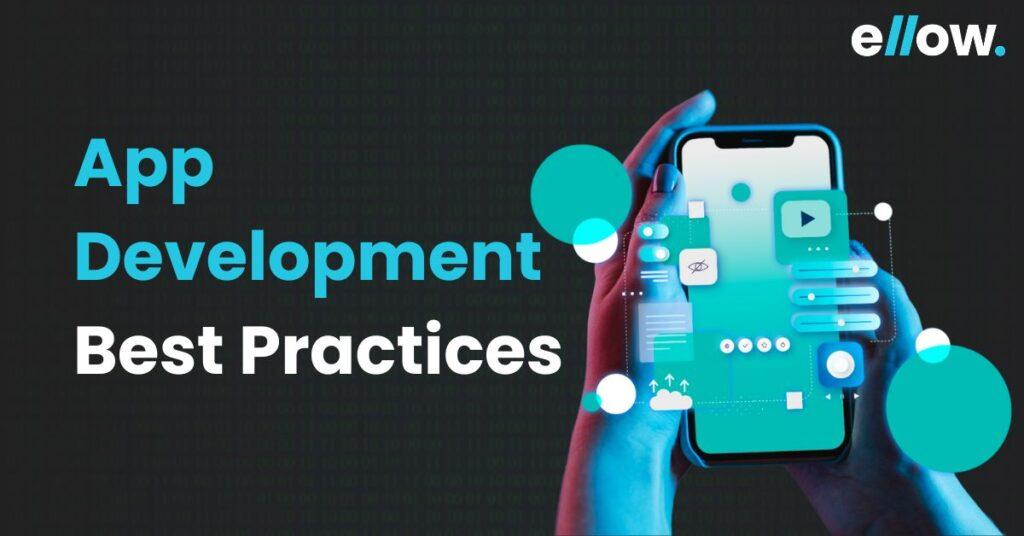
Blog
App Development Best Practices: Latest Trends
- Suvankar Das
- September 18, 2023
- 3:23 pm

In the dynamic world of app development, staying current isn’t just a luxury—it’s a necessity. As technology pivots and users’ expectations evolve, so do the strategies and practices employed by top developers worldwide.
Gone are the days when a static design and one-size-fits-all approach would suffice. Today, with millions of apps clamoring for attention in various app stores, it’s the innovative, user-centric, and trend-aware apps that rise to the top.
Whether you’re a seasoned developer looking to refine your approach or a newbie eager to start on the right foot, understanding the latest best practices is crucial. Dive in as we explore the cutting-edge trends shaping the app development landscape of today and tomorrow.
Table of Contents
Best Practices for Mobile App Development
A successful mobile application development always starts with quality research. Research is one of the app development best practices you should not miss out on. It helps to know the market trends and challenges and recognize your competitors and audience.
1. Research Market Trends, Audience, and Competitors to Develop Strategic Plan
Research helps to understand your customers, their interests, and their needs. It’s necessary to get updated about the market trends and changes people are looking for. You also need to look at your target audience’s preferences.
Widening your app’s target market must not be your priority but it’s necessary to include people who might be interested in your app. You don’t want your competitors providing much better services than yours. Try standing stronger against your competitor by analyzing your competitors, and learning their strengths and weaknesses.
2. Concentrate on Customer Experience
Your application might look great but would people really prefer to use it? You may not want to put your customers into a poor experience using your app which can create a negative impact on your app. Customer experience is a vital part to focus on in mobile application development best practices. Your customers must enjoy the experience of using your application.
- Update Mobile App based on User Feedback
Receiving feedback from the customers plays a crucial role in improving your application in the next update. Do not hesitate to consider the reviews and feedback from users. Also, you can work on improving the application in the next update considering the data retrieved from the actual use of the application.
3. Treat Security with the Utmost Priority
Regarding mobile application development, security should be high on your priority list. When people start using your application, there will be a flow of sensitive data and information into your system. It’s your responsibility to make your users feel secure while using your mobile application.
Best security practices of mobile app development include source code encryption, database encryption, securing the backend, securing APIs, data backup plans, and strong user authentication.
4. Create a Simple yet Intuitive UI/UX Design
UX and UI design are important things to be considered in application development to keep your audience engaged. A simple and user-friendly UI can help the application users understand it better and use it faster and more efficiently.
5. Implement Automation Testing
Your mobile application requires automation testing from the developers to check its functionality, accessibility, and security regularly. It ensures the user experience and provides better results. Implementing automation testing helps to improve app usability, performance, security, and app loading.
6. Integrate with Third-party
Third-party integration to your mobile application helps in saving time and effort. It reduces errors, enhances functionality, increases customer retention, and improves overall experiences. It can benefit by satisfying your users and providing them with added features. It’s a great practice in mobile app development with many business apps implementing it. For instance, Uber uses Google Maps for navigation.
7. Make Cloud-Based
Cloud-based apps are one of the important app development practices and there are several reasons behind this.
Cloud-based mobile applications have been used by many companies and businesses. It helps in data collecting to make it more convenient, can offer seamless database integration, provides more safety, and enhances customer experience by creating productivity-based applications.
It doesn’t require any upfront payments and robust infrastructure. With cloud-based application development, you don’t need to purchase or configure hardware and software.
8. Apps For Foldable Devices
The arrival of foldable devices has resulted in major changes in the application development industry with a lot of businesses and companies have started exploring this technology. The major idea of the technology is to provide users with better multitasking and user experience.
The development of foldable apps requires a larger screen, new content types, and more features that are able to fit on a single screen. It can take much time and higher cost which can be challenging for developers. However, it’s one of the mobile app development best practices for companies as the use of foldable technology has been rising.
9. Chatbots
Chatbots are mostly integrated by companies in order to improve customer engagement and productivity of the company. It’s beneficial as it reduces human dependency, and provides customer services with AI-powered bots or fixed bots. People prefer using chatbots to get services and make purchases.
Integrating chatbots in mobile applications has been a common practice in app development projects. For instance, Amazon uses a chatbot to handle customer queries and save time.
What are the latest app development trends?
1. Augmented Reality (AR) and Extended Reality (XR) Enrichment
In the world of advancing technology, Augmented Reality (AR) and Extended Reality (XR) are two trending topics in mobile application development. AR is a technology that overlays virtual content in the real world. It creates a mesmerizing experience that integrates virtual content with a real-world environment. XR mixes Artificial Intelligence with Virtual Reality and Mixed Reality to create a more realistic experience.
AR has a great ability in mobile application development which can fit into various kinds of apps. With the ability to create interactive experiences, Augmented Reality is about to change the way we use our mobile devices.
2. Progressive Web Apps (PWAs) Proliferation
Progressive Web Apps (PWAs) are web applications that function like native mobile apps. PWAs use HTML, CSS, and JavaScript code to build that’s hosted on web servers and that runs in web browser engines. You can access Progressive Web Apps through a web browser and install them on the home screen, making them easily discoverable.
The benefits you get in PWAs are reliability, recall, and higher engagement. You can consider PWAs as alternatives to native mobile apps because they can be set up on any browser and have highly responsive construction.
3. Development For Wearable Devices
Modern technologies enable apps to connect to and run on wearable devices such as smartwatches, fitness bands, smart glasses, and many more. The apps use the internet or Bluetooth to make a connection to wearable devices. Wearable devices are becoming increasingly popular, and the demand for wearable apps is on the rise. The wearable devices market is growing at a higher rate which also increases the demand for wearable app development.
4. Artificial Intelligence (AI) and Machine Learning (ML)
Artificial Intelligence (AI) and Machine Learning (ML) both are popular topics in mobile application development. AI is a technology that makes machines do work that often requires human intelligence, such as translation, customer services, text correction, navigation, and speech recognition.
Machine Learning is a branch of AI that enables machines to use data and algorithms to act and respond like human behavior. In any mobile application development practice, AI comes with a huge potential. A lot of smartphone apps have already been using it. The ability to create intelligent experiences indicates that there will be an increment in the integration of Artificial Intelligence and Machine Learning in mobile applications.
5. Mobile Wallet and Payments
Mobile Wallet and Payments are among one of the most popular mobile app development trends.
According to a report by Statista, mobile wallets accounted for roughly half of global e-commerce payment transactions in 2022. The report also states that the mobile wallet market size varied significantly between regions, with nearly half of the 2.8 billion mobile wallets in use worldwide being in Asia-Pacific alone.
As per Experts from CDR Report Writer, the rise of super wallets, AI-powered financial assistants, and wearable devices complementing mobile wallets are some of the trends to watch in this space. As comfort, security, and responsiveness grow in importance for users, mobile payment usage is expected to increase at a big rate.
6. Blockchain Technology
Blockchain technology is revolutionizing the mobile app development industry for Blockchain Developers by providing a secure and transparent payment process, reducing the need for intermediaries. It also allows developers to keep a transparent and immutable record of transactional digital information, ensuring that there is no tampering with data.
Blockchain technology provides increased data security, transparency, and reliability to mobile applications. It is expected that this technology can substitute app stores and will be mainly used for downloading, buying, and searching.
Open-source blockchain platforms such as OpenChain, MultiChain, HydraChain, Eris, BigChainDB, Hyperledger, and Stellar are available for facilitating the development of blockchain-based mobile apps.
What are new commonly used app development Frameworks
Cross-platform mobile app development frameworks such as React Native, Flutter, Xamarin, Ionic, NativeScript, Apache Cordova, Framework7, JQuery Mobile, Sencha Ext JS, and Onsen UI are some of the commonly used frameworks for new app development technologies
How to Choose the Right Framework for App Development?
The increasing usage of smartphones has made mobile applications more necessary for businesses and companies as they look forward to expanding their services. Choosing the right framework for mobile app development is a crucial step in the development process. Developers must consider several factors before selecting a framework.
Firstly, they must identify their ultimate goal behind mobile app development. The tech stack they select must be decided based on their application’s ultimate goal.
Developers should consider the time consumption of the framework next. A framework that takes too long to complete can hinder the product release and increase the final budget.
You should choose a developer-friendly framework to have a smooth headway to the final product. Scalability is another requirement that developers should consider. A scalable mobile app development framework should be flexible when the user base grows.
Finally, developers should consider cross-platform frameworks such as React Native, Ionic Framework, Node, Xamarin, NativeScript, Adobe PhoneGap, and Flutter.
What is the next big thing in software development?
There are a lot of things progressing in the field of software development with technology advancing continuously. The trending topics these days that are assumed to be the next big things in software development are Artificial Intelligence (AI), Progressive Web Apps (PWA), 5G connectivity, and Augmented Reality (AR).
AI has already made its way into mobile applications and it is expected to become more common in the future. AI-powered mobile apps analyze user’s preferences and behavior to provide personalized experiences to them.
PWAs are web applications that have the functionality of native apps. It can access features like camera, contact, and location from the user’s device. PWAs are fast, reliable, and can work offline. You can use PWAs across multiple platforms including iOS and Android.
Another hot topic in software development is low-code or no-code app development. Using low-code or no-code application development, one can create mobile apps without requiring coding knowledge. You can build any kind of high-quality mobile application using this platform. However, you might not like these platforms for the advanced development of mobile applications that require custom coding.
Conclusion
The demand for smartphone applications for businesses and companies is constantly increasing. In order to maintain quality, you need to keep your app up-to-date with the latest trends and provide a great user experience.
There are a few trends you might want to integrate or follow in mobile app development to make your app perfect. The trends include cross-platform development, artificial intelligence, Internet of Things (IoT) integration, security and privacy, and user experience (UX) design.
A good app design must require market research, usability, high performance, security, thorough testing, and excellent user support. You can create engaging and convenient apps by allowing these trends in mobile app development practices.







